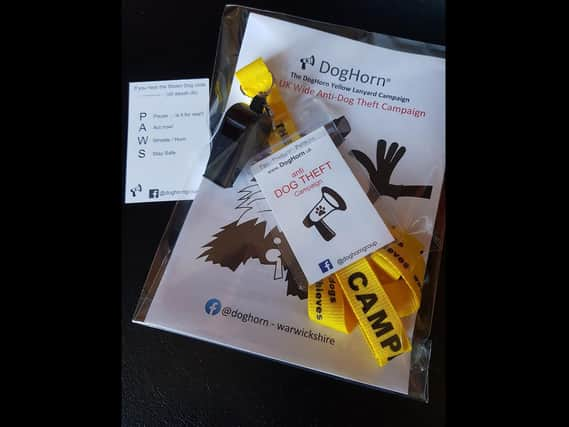Warwickshire dog owners use tactics borrowed from Bobbies of yesteryear to prevent kidnappings
This article contains affiliate links. We may earn a small commission on items purchased through this article, but that does not affect our editorial judgement.


In the days before radios and response vehicles, the Bobby on foot patrol would use their whistle to summon assistance and alert colleagues to danger.
This system was extremely effective in helping to clean up Victorian Britain's violent and theft-ridden cities, making those in towns and cities just seconds or minutes away from help.
Advertisement
Hide AdAdvertisement
Hide AdAt the time the manufacturer of the police whistle also advertised it to the general public as a means of summoning assistance in dangerous situations.
And today personal attack alarms, which serve as an alternative to whistles, remain the only item that police say members of the public are permitted to carry to be used for self defence.
Now a group set up in Warwickshire is using similar tactics to the Bobbies of old in an attempt to stamp out dog kidnappings.
DogHorn was set up in Northumberland last year by Nigel King after his dog went missing in what was believed to be a theft.
Advertisement
Hide AdAdvertisement
Hide AdAnd as dog thefts have been on the rise across the country through lockdown, the group has expanded, with volunteers setting up regional branches.
Leamington resident Steve Turner recently set up Warwickshire's DogHorn branch, and earlier today he spoke with this newspaper to explain how the campaign can help to keep dogs and owners safe.
The first step is to buy the DogHorn yellow lanyard and whistle and to carry it with you while out.
The pack is available for £5 and is sold at cost, with any profit going straight back to supporting the campaign and buying more supplies.
Advertisement
Hide AdAdvertisement
Hide AdAnyone who believes they are being followed or approached by potential dog thieves gives three blasts of the whistle - one short, one long, one short - to call for assistance and to alert other people of the danger.
Then, anyone hearing the signal for distress is encouraged to first pause and consider whether the signal is both correct and being made by someone genuinely in distress.
If thought to be genuine, the responder is then encouraged to act - by repeating the signal with their own whistle or a car horn and then, depending on how safe they feel, to approach the situation, record and call the police.
Steve said: "This is where we have to do our own risk assessment, but if you see someone being attacked or followed, you can help by approaching the incident, recording and calling the police.
Advertisement
Hide AdAdvertisement
Hide Ad"Most of these thefts are being done by opportunists, they're not organised or planned.
"The idea is that by wearing the DogHorn Lanyard you are broadcasting that you are aware of your surroundings.
"We believe these opportunistic thieves can be deterred if you show that you are aware of your surroundings, you signal for help and then you potentially have several people approaching the situation to help by recording, phoning the police and repeating the signal.
"If the worst does happen and your dog is stolen, with people across an area repeating the signal with whistles and car horns we hope to create a ring of vigilance, making it harder for a thief to get away.
Advertisement
Hide AdAdvertisement
Hide Ad"And then, if you hear the signal and you see someone clutching a dog and running, you can pull out your phone and record them.
"Sometimes knowing they've been caught on camera can be enough to make them put the dog down and run away."
Steve stressed that, while the problem is growing nationally, incidents in Warwickshire remain rare.
He said: "In Warwickshire the police have had two reported thefts in the last month, and one of those was a working dog.
Advertisement
Hide AdAdvertisement
Hide Ad"It's important that we spread awareness, not hysteria - we want people to be vigilant but we don't want them scared."
Steve also recommends that residents report any suspicious activity to Warwickshire Police, either by calling 101 or visiting their website.
"If enough people report the same activity, the police will drive into the area, and a police presence will force the thieves to move on.
"The aim here is to make Warwickshire a place that is very difficult for thieves to work in, so they will move to another county, where people there can use the same tactics to keep them moving on."
Advertisement
Hide AdAdvertisement
Hide AdThere are six volunteers working with Steve to run the Warwickshire group and distribute the whistle and lanyard packs, including Taylor-Jane Twigger in the Rugby area.
Steve said he wishes to thank all volunteers for their hard work.
Those wishing to learn more, or to buy their own whistle and lanyard pack, can visit www.facebook.com/groups/doghornwarwickshire